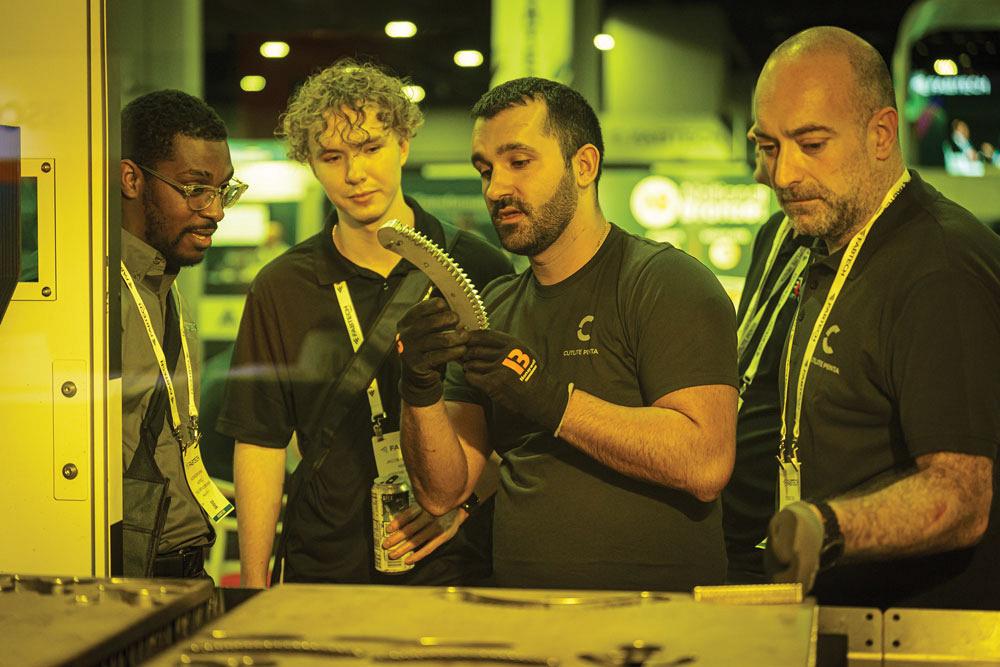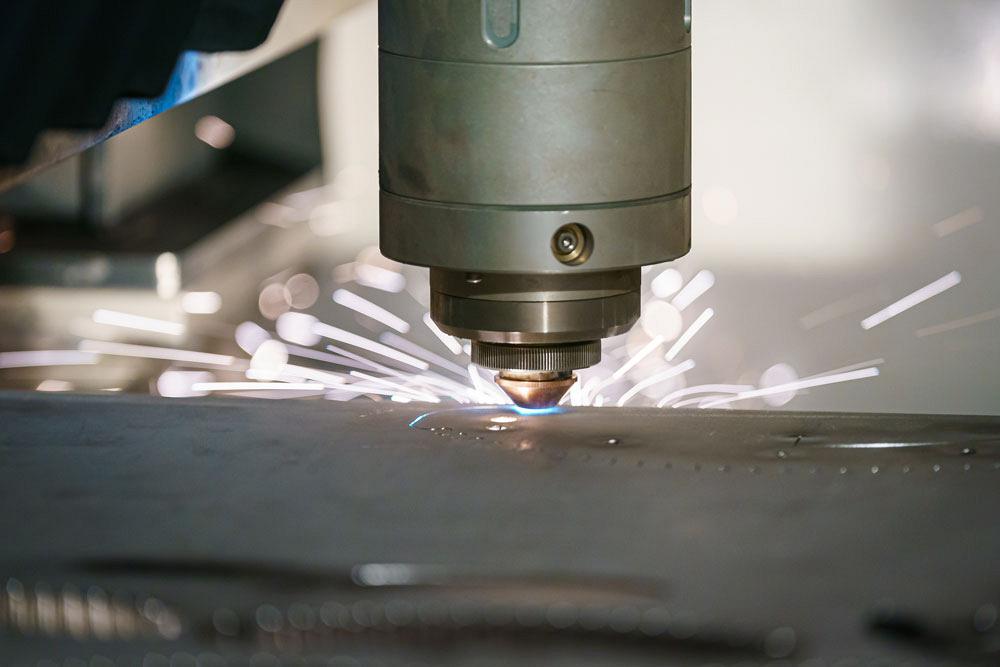- FMA
- The Fabricator
- FABTECH
- Canadian Metalworking
Fabricators connect at FABTECH in Atlanta
The digital transformation in metal fabrication gets real
- By Tim Heston
- January 19, 2023
- Article
- Fabricating
During the opening keynote of FABTECH 2022, Gillen Young pointed to a map of the U.S. overlayed with a dense stitchwork of crisscrossing lines. As chief architect of IoT solutions at AT&T, Young used that image to show just how far networking infrastructure has come.
“I’ve landed on two key points,” Young said. “We need to remind ourselves how important being connected really is. The second is about the digital transformation. Be aware of the pace it’s happening. It’s going to have an impact on business, small businesses in particular, whether you’re a machine operator, a plant engineer, or a CEO… You have to start somewhere. And be prepared. Where you think you’re going when you start will change. You’ll learn there are different drivers of value from when you started.”
Among all the worry in the broader economy—inflation, geopolitics, lockdowns and protests in China, headline-grabbing layoffs in the tech world—nearly 30,000 people from the metal forming and fabrication industry came to Atlanta Nov. 8-10 to see what’s new. Attendance grew more than 20 per cent over FABTECH 2021, the first show since the pandemic started. Rosy outlooks for 2023 dominated the event. Evidence of reshoring abounded. Few saw any layoffs in their future, but many saw significant change, especially regarding automation.
In a broad sense, technology isn’t being deployed through brute force, with the aim of gaining more inches or strokes per minute or more parts per hour. All the laser cutting speed in the world doesn’t matter if it’s just feeding a bottleneck stemming from internal inefficiency, miscommunication, or supply chain problems.
As Young stated, the drivers of value are changing. It’s no longer just about who has the most cutting, bending, or welding capacity, though having that raw processing power is still a big piece of the puzzle. It’s about who has the best information to use that capacity well and give customers what they want: a reliable metal fabrication partner.
Reshoring Demands Capacity
“We had a drastic drop-off with the pandemic, but then demand came back with a fury. We’ve seen many [customers] move their supply chains from overseas. They’re onshoring to shorten lead times.”
That was Jammie Robbins, sales manager of Dayton, Ohio-based Staub Manufacturing, a custom fabricator that exhibited at the show. In recent years, the company has invested aggressively in automation.
“We have full laser cutting automation that we installed several years ago,” he said, adding that the company actually reduced the number of laser cutting machines it has, replacing four slower CO2 systems with two high-powered fibre laser machines. The result: more production in a smaller footprint—which, as Robbins explained, the company needs to meet rising demand.
Automation investment in metal fabrication continues unabated. A few rows down from Staub, exhibitor Hafendorfer Machine, a Louisville, Ky.-based custom fabricator and machine shop, recently invested in laser cutting as well as bending automation, with collaborative robots tending press brakes. Company President Jim Hafendorfer doesn’t foresee curbing automation investment anytime soon, at his shop and in the industry at large. “In the future, I think we’ll start to see automation that takes parts from the laser to bending cells, to keep WIP [work-in-process] on the move through the shop.”
Automation investment can’t be made off the cuff, of course. It takes data, planning, foresight, and, not least, skilled employees to program, run, and maintain the equipment.
“All companies, and small businesses in particular, need to have the mindset and an internal support structure to support their equipment investment. That’s the most challenging thing, because the people who do this are very difficult to find. Manufacturers need to be willing to grow.”
So said George Mirabella, commercial development consultant for Gain & Co., an automation consulting firm with U.S. offices in Chicago that was sharing a booth with #HowToRobot. Both based in Denmark, the two companies help manufacturers start and strategize their transformation toward automation. #HowToRobot serves as an online matchmaking service for those looking to automate a specific process. As Ryan Shook, commercial development manager, put it, “There’s a matchmaking algorithm that takes place, so that [the details for a certain job] gets sent to relevant suppliers who do that kind of work.”
Gain & Co., on the other hand, offers broader consulting services. Chuck Mraz, senior commercial development manager for Gain, described how he helps manufacturers develop a kind of automation road map. “A lot of companies concentrate their automation efforts in a specific area, but we find they’re automating in the wrong places. This is where an automation road map becomes important. Companies need to take it step by step. Forget the robots and machines for a second. How does work in the factory flow? Where are the issues? Where do you want to be in five years?”
This thinking gets fabricators beyond the typical scenario of automating for a particular application, then seeing the automated equipment sit idle after a job or contract ends. Such a scenario has led to many robots (especially in welding) sitting in the corner or in storage, idle for years.
About Having Good Information
Today’s automation has gotten more flexible. For instance, Path Robotics and Abagy Robotic Systems (two firms with nearby booths in the welding hall) have introduced robotic systems that require no manual programming, just access to the 3D CAD file with welding information, including size and length.
As long as automation has good information, it can perform. Getting the right information, though, isn’t always so easy. “There’s a lack of connectivity across the industrial supply chain. And as you move through the tiers of the industrial supply chain, the quality of information declines. We can fix that problem.”
That was Jason Ray, CEO and co-founder of Boston-based Paperless Parts, a cloud-based quoting platform. At the show, Ray described an industry supply chain with a serious lack of transparency. On top of this, information tends to degrade the farther down the tiers you go. Designers start with a powerful 3D CAD file, then convert to a STEP file as they start the procurement process. Lower-tier suppliers, including many precision sheet metal fabricators, are left with a PDF. Sometimes they can get a 3D CAD file, sometimes not. The more information a fabricator has earlier in the process—ideally, starting from the initial quote—the more efficient its operation can be.
“Digital transformation can be practical. It’s not rocket science. A lot of it is about integrating your business processes.”
That was Steve Bieszczat, a Paso Robles, Calif.-based chief marketing officer at Dassault Systemes, in a talk during the FABTECH conference, where he added that streamlining the front office is today’s low-hanging fruit of metal manufacturing efficiency. Yes, upgrading a laser or press brake can boost throughput, perhaps by minutes or hours, but uncovering bottlenecks in the office can shave days or even weeks off the production cycle.
Such waste, both in the office and in the shop, boils down to not having the right information at the right time. To rectify this, manufacturing execution systems (MES) that help communicate part- and job-specific data throughout the company, eliminating manual keystrokes in quality assurance (or part checks at the machine when practicing quality at the source). Other solutions include information transparency (think web portals) between a customer and fabricator to better synchronize outside services, like coating or plating. Or it can be as simple as digitizing a job traveler. The more information a fabricator gathers, the better it can plan.
“The [digital] transformation is moving to the point where before we do something, we can simulate what the outcome is going to be,” Bieszczat said. He added that simulation has moved to various realms of the manufacturing business, including purchasing, forecasting, scheduling, even part design. “We’re now moving into the realm of ‘simulate before you act.’”
Data and connected machines will help make this happen, along with predictable and repeatable processes—which, of course, is one big benefit of well-designed, planned, and maintained automation. It could be a part removal system, a welding robot, or an autonomous mobile robot (AMR) moving work between processing steps. (This year, a few AMRs graced the floors at FABTECH, showing how cutting could connect to bending and beyond.) All this motion can be tracked, measured, repeated, and perfected.
But what about manufacturing steps that really can’t be automated, at least not cost-effectively?
“We’re continuing to automate and broaden our services,” said Randy Hauser, president of Chicago Metal Fabricators, a Chicago-based custom fabricator that exhibited at the Atlanta show. “We’ll likely be delving into more assembly.”
Hauser isn’t alone. Thing is, expanding into assembly, especially in high-product-mix environments with highly variable or seasonal demand, can add significant variability.
Say a shop relies on dozens of temporary workers to get the operation past a demand spike. Here, Andrew Robling, Georgetown, Ont.-based principal product manager at Epicor Software Corp., described a scenario involving a new assembler using a torque gun connected to software that tracks the torque level. “It can take a long time for someone to understand all the steps required in an assembly,” he said, adding that with the right software, “they can follow directions on the screen, which brings them through the steps and gets them onboarded a lot faster. Not only that, it’s checking what they’re doing, and you know you’re getting a good part. And if you find that assemblers always have problems with a certain nut, that can lead to an improvement program.”
Protect Your Data
With data being collected throughout a fabricator’s value chain from quote to ship, improvement becomes more powerful. In fact, such data can become a fabricator’s primary asset—and it needs to be protected.
“I got the call at 7:30 in the morning. My client had virtualized servers that were all down and they didn’t know why. By the afternoon, we had a better idea of what was going on. We found a ransom note from a cybercriminal.”
That was Bryce Austin, CEO of TCE Strategy, during a presentation the first morning of the show. TCE is a cybersecurity firm that worked with Wilson Tool, the Minnesota-based tooling manufacturer that experienced a data breach earlier in 2022. “We found, regrettably, that the cybercriminals were using ransomware with new kinds of code,” Austin said. “We knew it was going to be a long day.”
Wilson Tool remained open, and “in fact, productivity never fell below 90 per cent,” Austin continued. “We also had a financial runway. Sometimes, if we can’t get revenue going again within days or weeks, the company is in trouble. In this case, the company was so well run, we had time to get this resolved. We engaged law enforcement and got to work.”
Wilson Tool presented at FABTECH to spread the word about how important cybersecurity has become. Several of the show’s speakers described just how vulnerable fabricators are.
In fact, manufacturing has become one of the most vulnerable industries for cybercriminals, who now are taking a “bottom up” strategy. Instead of attacking large OEMs, the criminals sneak into their suppliers’ less secure systems—hence the need for cybersecurity certifications for defense contractors and others. The reality is that as more information becomes digital and customers and suppliers share more information, the more important cybersecurity becomes.
The very fact that cybercriminals are targeting smaller manufacturers implies another reality: Fabricators aren’t in the parts business anymore; they’re in the information business. After all, there’s nothing stopping a competing shop with available funds (and perhaps a little gumption) to purchase similar or identical equipment. A shop with better information, though, might help its skilled talent to produce a better part or deliver it in a more cost-effective way. In all this, software, equipment, and skill will play starring roles. And at FABTECH 2022, all three were present in droves.
Contributing Editor Tim Heston can be reached at timh@thefabricator.com. FABTECH’s event partners are the American Welding Society, Fabricators & Manufacturers Association International, SME, Precision Metalforming Association, and the Chemical Coaters Association International. For more information, visit www.fabtechexpo.com.
About the Author

Tim Heston
2135 Point Blvd
Elgin, IL 60123
815-381-1314
subscribe now


Keep up to date with the latest news, events, and technology for all things metal from our pair of monthly magazines written specifically for Canadian manufacturers!
Start Your Free Subscription- Industry Events
Automate 2024
- May 6 - 9, 2024
- Chicago, IL
ANCA Open House
- May 7 - 8, 2024
- Wixom, MI
17th annual Joint Open House
- May 8 - 9, 2024
- Oakville and Mississauga, ON Canada
MME Saskatoon
- May 28, 2024
- Saskatoon, SK Canada
CME's Health & Safety Symposium for Manufacturers
- May 29, 2024
- Mississauga, ON Canada























